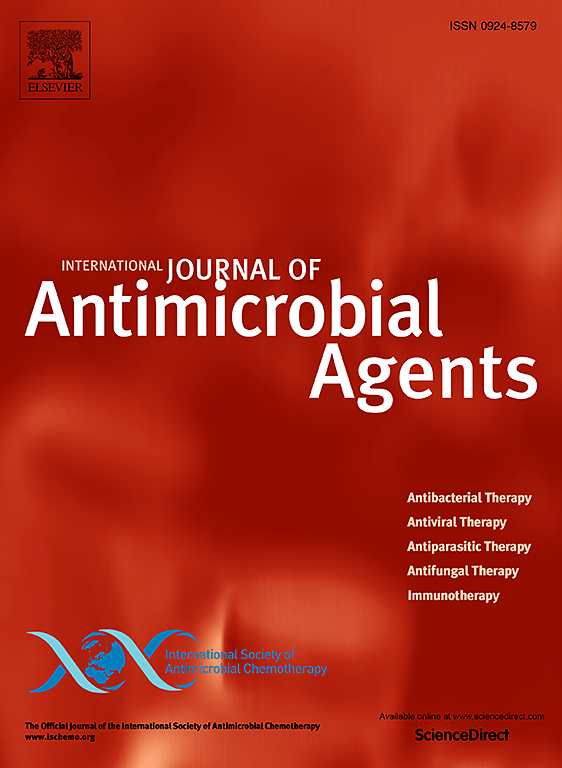Clinical outcomes of a twice-daily metronidazole dosing strategy for Bacteroides spp. bloodstream infections
IF 4.9
2区 医学
Q1 INFECTIOUS DISEASES
International Journal of Antimicrobial Agents
Pub Date : 2024-12-10
DOI:10.1016/j.ijantimicag.2024.107403
引用次数: 0
Abstract
Objective
The optimal dose of metronidazole for the treatment of Bacteroides spp. bacteraemia has not been well defined.
Methods
This study was a multi-centre, retrospective chart review of adult patients with bacteraemia secondary to Bacteroides spp. between October 2010 and March 2024. Clinical outcomes of patients who received metronidazole 500 mg twice daily were compared with those who received metronidazole 500 mg thrice daily. Clinical failure was defined as a composite of 30-day recurrent infection due to Bacteroides spp. or all-cause mortality.
Results
Of the 242 patients who met the inclusion criteria, 76 received metronidazole twice daily and 166 received metronidazole thrice daily. Patients who received metronidazole twice daily did not have significantly different rates of clinical failure (15% vs 18%; P=0.561) or 30-day mortality (15% vs 17%; P=0.638) compared with those who received metronidazole thrice daily. After applying full-cohort matching, patients who received metronidazole twice daily were not at increased risk of clinical failure [odds ratio (OR)=0.859, 95% confidence interval (CI) 0.283–2.606; P=0.801] or 30-day mortality (OR=0.897, 95% CI 0.292–2.752; P=0.8573) compared with those who received metronidazole thrice daily.
Conclusions
In the largest study to date of patients with Bacteroides spp. bacteraemia treated with metronidazole, twice-daily dosing strategies were not associated with worse outcomes compared with thrice-daily dosing strategies.
每日两次甲硝唑给药治疗拟杆菌血液感染的临床效果。
目的:甲硝唑治疗拟杆菌的最佳剂量尚未明确。方法:本研究对2010年10月至2024年3月期间成年拟杆菌属继发性菌血症患者进行多中心、回顾性图表分析。将每日两次500mg甲硝唑治疗组与每日三次500mg甲硝唑治疗组的临床结果进行比较。临床失败定义为由拟杆菌引起的30天复发感染或全因死亡。结果:242例符合纳入标准的患者中,76例接受甲硝唑500mg每日2次治疗,166例接受甲硝唑500mg每日3次治疗。每日两次接受甲硝唑治疗的患者与每日三次接受甲硝唑治疗的患者相比,临床失败率(15% vs 18%, P=0.561)或30天死亡率(15% vs 17%, P=0.638)无显著差异。应用全队列匹配后,每日两次接受甲硝唑治疗的患者临床失败风险没有增加[OR=0.859;95% ci (0.283-2.606);P= 0.801]或30天死亡率[or = 0.897,95% CI (0.292-2.752) P=0.8573]。结论:在迄今为止对甲硝唑治疗的拟杆菌属菌血症患者进行的最大规模研究中,与每日三次甲硝唑给药策略相比,每日两次给药策略与更差的结果无关。
本文章由计算机程序翻译,如有差异,请以英文原文为准。
求助全文
约1分钟内获得全文
求助全文
来源期刊
CiteScore
21.60
自引率
0.90%
发文量
176
审稿时长
36 days
期刊介绍:
The International Journal of Antimicrobial Agents is a peer-reviewed publication offering comprehensive and current reference information on the physical, pharmacological, in vitro, and clinical properties of individual antimicrobial agents, covering antiviral, antiparasitic, antibacterial, and antifungal agents. The journal not only communicates new trends and developments through authoritative review articles but also addresses the critical issue of antimicrobial resistance, both in hospital and community settings. Published content includes solicited reviews by leading experts and high-quality original research papers in the specified fields.

 求助内容:
求助内容: 应助结果提醒方式:
应助结果提醒方式:


